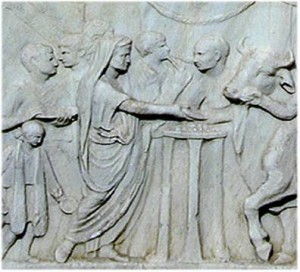September 13

The Romans knew how to party. So much so that their toga ensemble has become the symbol of a decadent good time, especially in the “Greek” system in colleges across North America. Of course the Greeks didn’t wear togas—the Romans got it from the Etruscans—but we’ll let that slide.
Thanks to writers like Ovid and Cicero, we know that every month of the Roman calendar was flooded with festivals and sacred days for the pantheon of gods and goddesses. With one exception:
September.
There were only two notable holidays in the seventh month. (September didn’t become the 9th month until the second century BC.)
On September 13th, Romans observed the Ides, the day honoring the Roman king of the gods, Jupiter.
But the Romans honored Jupiter every month on the Ides. The 15th of March, May, July, October, and December; the 13th of all other months.
The other September event was known as Ludi Romani, or the “Roman Games“.
Ludi Romani was one of the most anticipated and biggest events of the year, and in its heyday stretched for over two full weeks, from September 4 to September 19.
According to tradition, the first games were instituted by King Tarquinius Pricscus (Tarquin the Elder) in the 6th century BC, after a Roman military conquest. He created the Circus Maximus to hold such an event.

The Circus Maximus was constructed between two of Rome’s seven hills, Aventine Hill and Palatine Hill. At over 2,000 feet long, the Circus could seat upwards of 150,000 spectators, and more could view the Games from the surrounding hillsides.
The main event of the Games was chariot racing, or ludi circenses. These races could be far bloodier than any Ben Hur movie. Other attractions included boxing, battles with wild animals, and gladiator bouts, though these were all later moved to other venues designed for such events. (The lack of a barrier between the stands and the track didn’t protect spectators too well from wild animals.)
Originally the Games were only one day, then two: September 12th and 14th.
The Games were celebrated intermittently until 366 BC when they became “the first set of Ludi to receive annual sponsorship by the Roman state…” (The Roman Games: a Sourcebook, by Alison Futrell)
Three years later, ludi scaenici, or theater plays inspired by the Greek, premiered at the Games.
By the time of Julius Caesar the Games lasted two full weeks. After his assassination, Rome honored him…by adding another day.

